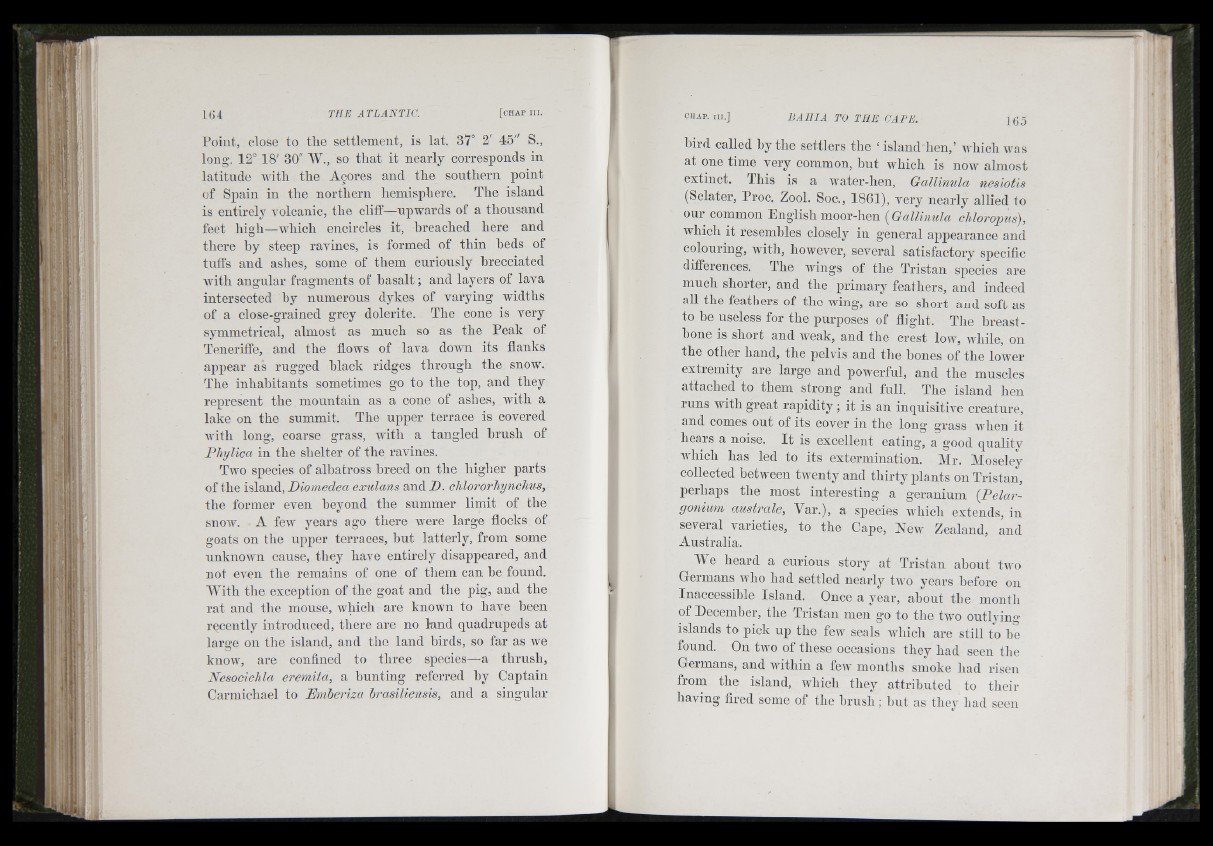
Point, close to the settlement, is lat. 37° 2' 45" S.,
long. 12° 18' 30" IV., so that it nearly corresponds in
latitude with the Acores and the southern point
of Spain in the northern hemisphere. The island
is entirely A'olcanic, the cliff—upwards of a thousand
feet high—which encircles it, breached here and
there by steep ravines, is formed of thin beds of
tuffs and ashes, some of them curiously hrecciated
with angular fragments of basalt; and layers of lava
intersected hy numerous dykes of A'arying widths
of a close-grained grey dolerite. The cone is very
symmetrical, almost as much so as the Peak of
Teneriffe, and the flows of lava down its flanks
appear as rugged hlack ridges through the snow.
The inhabitants sometimes go to the top, and they
represent the mountain as a cone of ashes, with a
lake on the summit. The upper terrace is covered
with long, coarse grass, with a tangled hrush of
Phylica in the shelter of the ravines.
Two species of alhacross breed on the higher parts
of the island, Diomeclea exulans and _D. chlororhynchus,
the former even beyond the summer limit of the
snoAV. A few years ago there Avere large flocks of
goats on the upper terraces, hut latterly, from some
unknoAA'n cause, they have entirely disappeared, and
not even the remains of one of them can he found.
With the exception of the goat and the pig, and the
ra t and the mouse, Avhich are known to have heen
recently introduced, there are no land quadrupeds at
large on the island, and the land hirds, so far as Ave
knoAV, are confined to three species—a thrush,
Nesocichla eremita, a hunting referred hy Captain
Carmichael to Pmheriza hrasiliemis, and a singular
hird called hy the settlers the ‘ island hen,’ Avliich was
at one time very common, hut which is noAv almost
extinct. This is a water-hen, Gallinula nesiotis
(Sclater, Proc, Zool. Soc., 1861), very nearly allied to
our common English moor-hen {Gallinula chloropus),
Avhich it resembles closely in general appearance and
colouring, with, howcA'er, several satisfactory specific
differences. The Avings of the Tristan species are
much shorter, and the primary feathers, and indeed
all the feathers of the wing, are so short and soft as
to he useless for the purposes of flight. The hreast-
hone is short and Aveak, and the crest low, Avhile, on
the other hand, the pelvis and the hones of the lower
extremity are large and powerful, and the muscles
attached to them strong and full. The island hen
runs with great rapidity; it is an inquisitiA'e creature,
and comes out of its cover in the long grass aaI icu it
hears a noise. It is excellent eating’, a good qualitA'
Avhich has led to its extermination. Mr. Moseley
collected between twenty and thirty plants on Tristan,
perhaps the most interesting a geranium {Pelargonium
australe, Var.), a species which extends, in
several varieties, to the Cape, New Zealand, and
Australia.
MY heard a curious story at Tristan about two
Germans who had settled nearly tAvo years hefore on
Inaccessible Island. Once a year, about the month
of Decemher, the Tristan men go to the tAvo outlying
islands to pick up the fcAv seals aaI iIcIi are still to he
found. On tAA'o of these occasions they had seen the
Germans, and Avitliin a fcAV months smoke had risen
from the island, which they attrihuted to their
having fired some of the hrusli; hut as they had seen